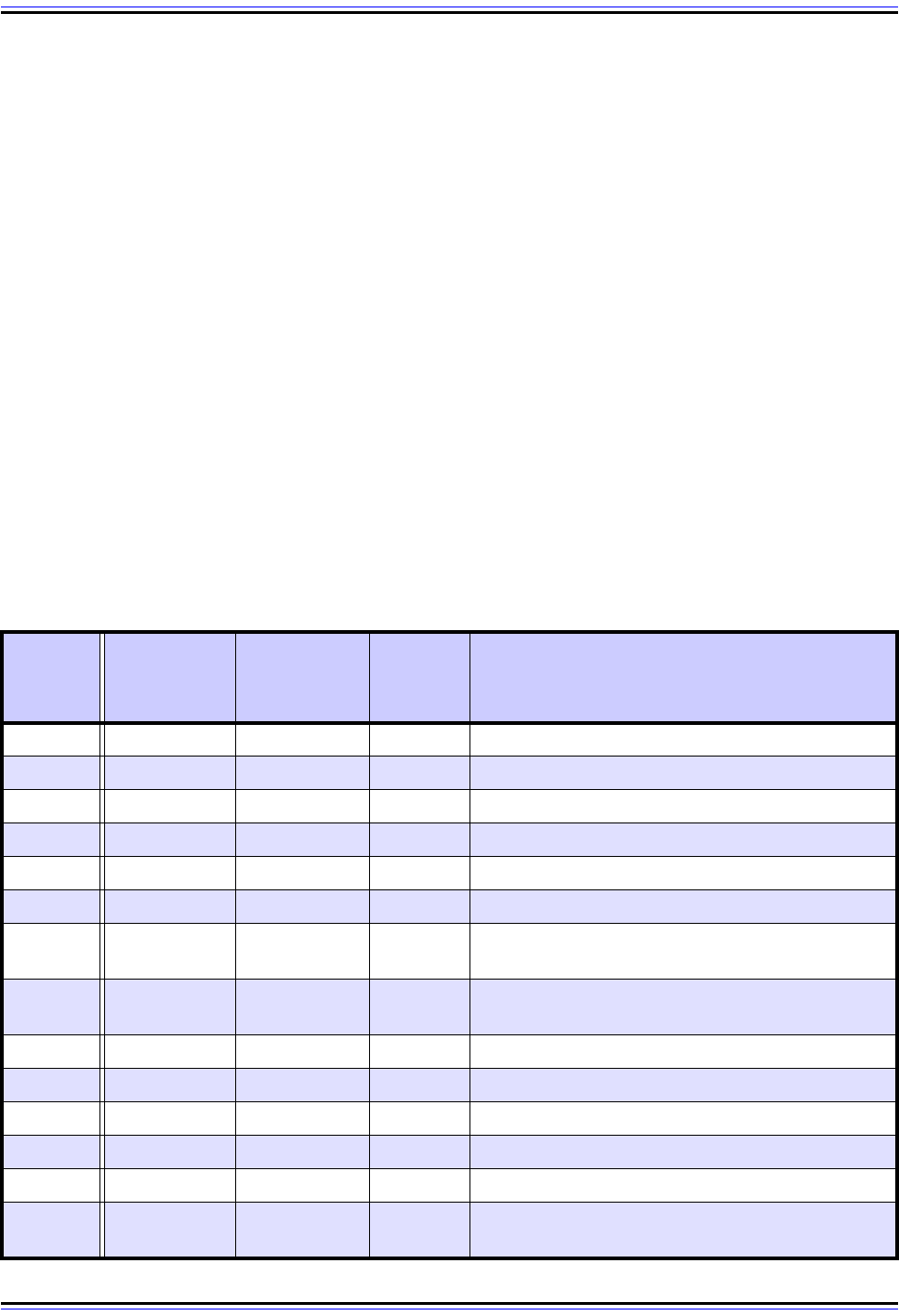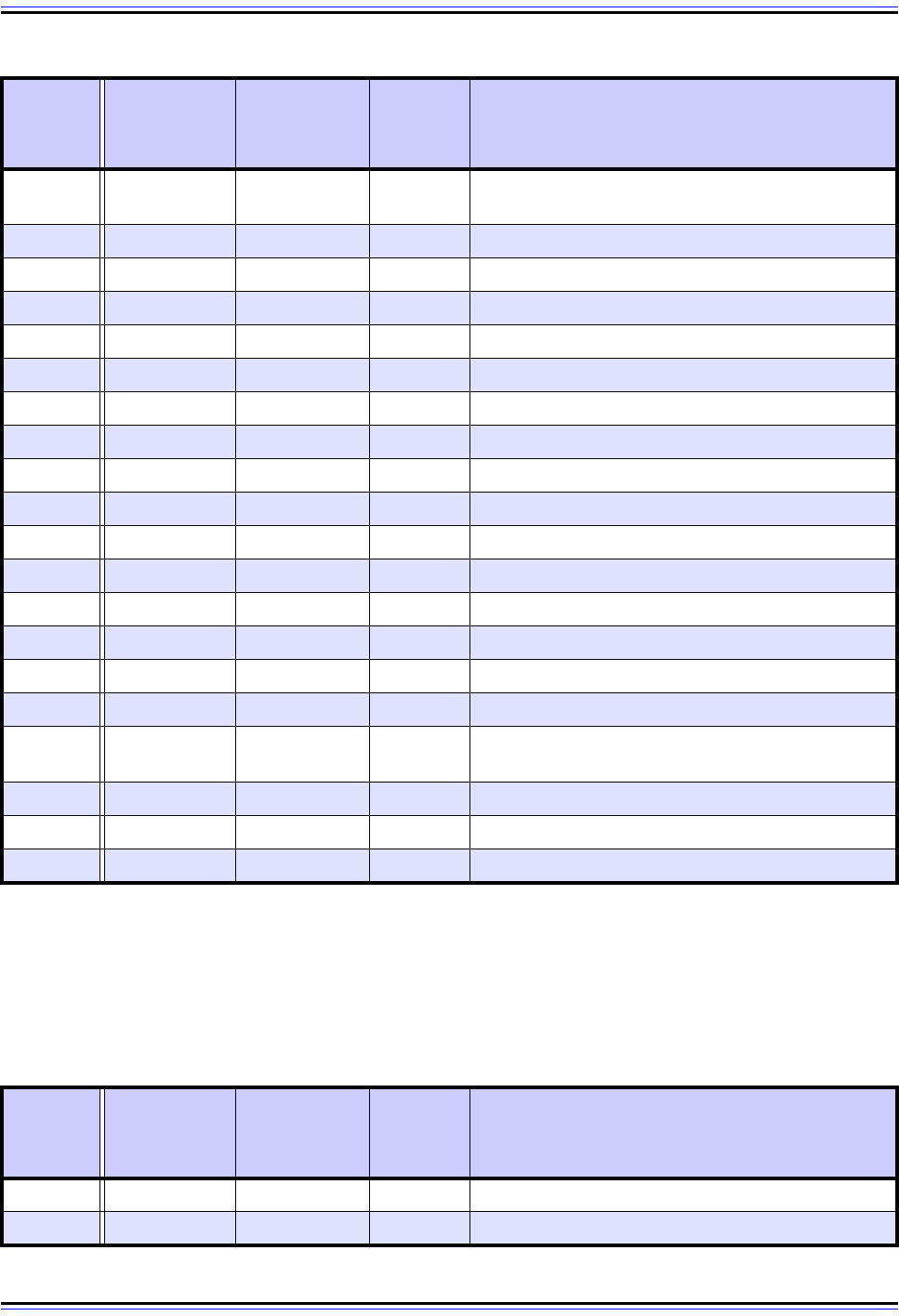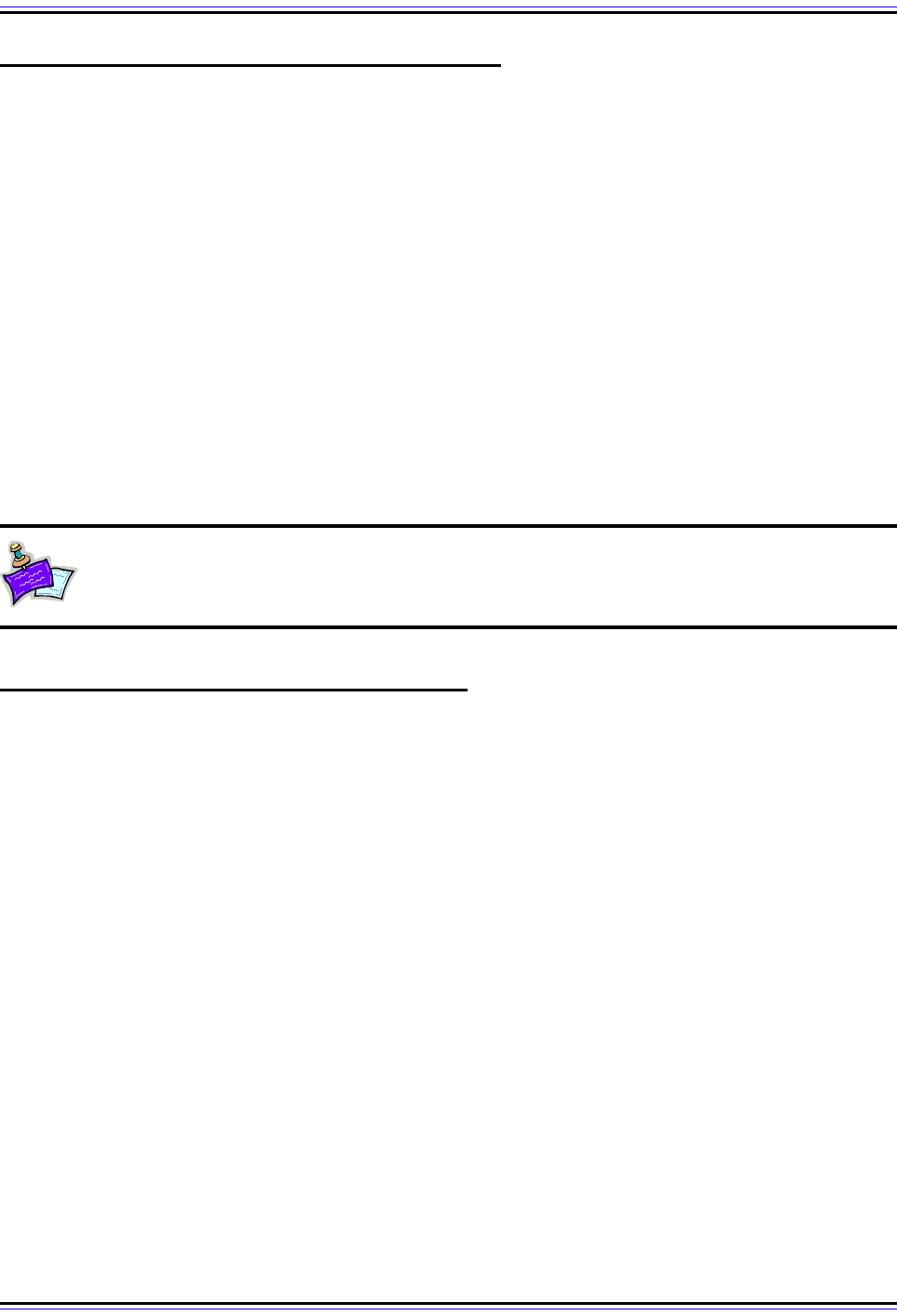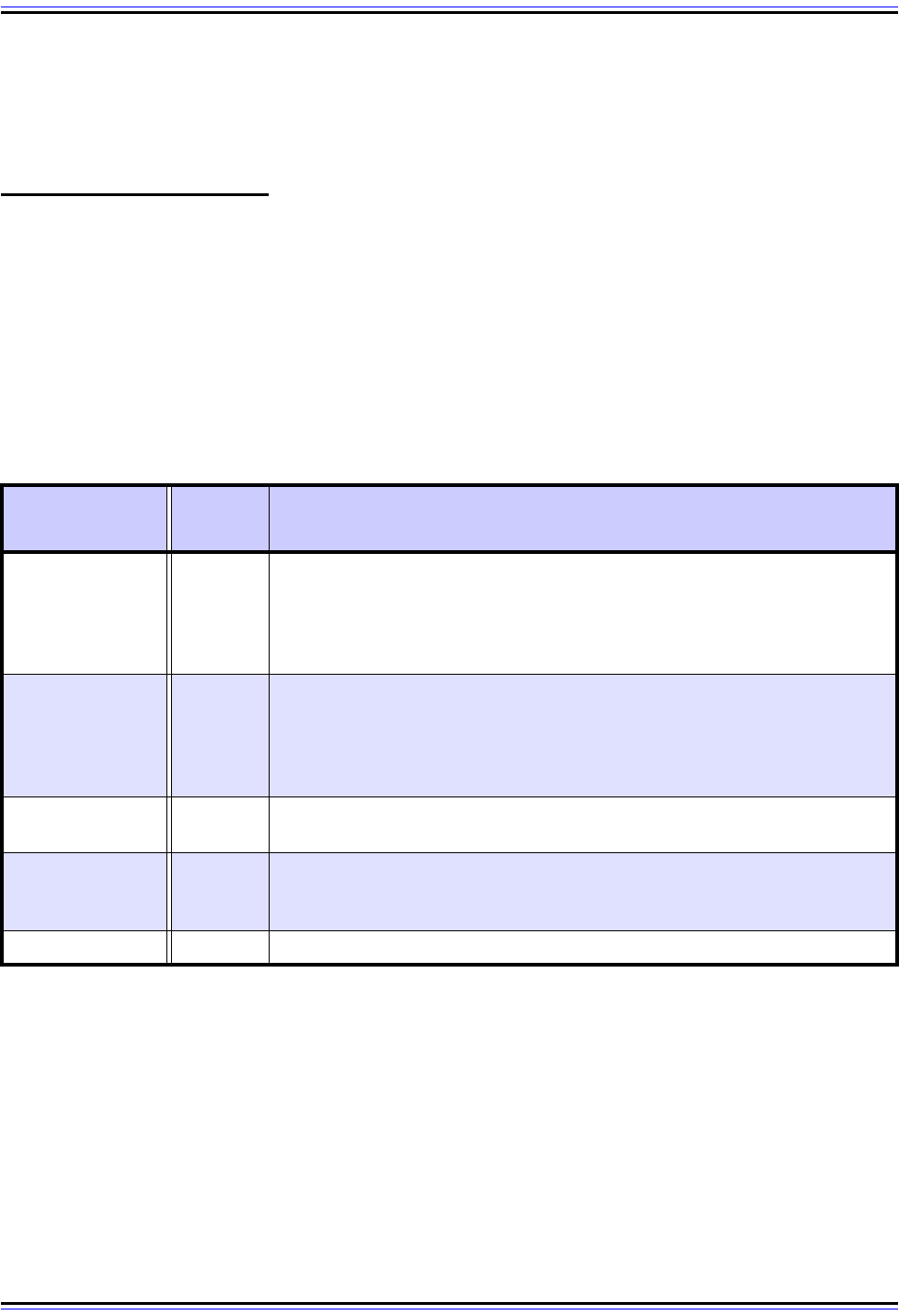Charles M. Kozierok The TCP-IP Guide
Подождите немного. Документ загружается.


The TCP/IP Guide - Version 3.0 (Contents) ` 821 _ © 2001-2005 Charles M. Kozierok. All Rights Reserved.
Key Concept: In most TCP/IP client/server communications, the client uses a
random ephemeral port number and sends a request to the appropriate reserved
port number at the server’s IP address. The server sends its reply back to whatever
port number it finds in the Source Port field of the request.
TCP/IP Sockets and Socket Pairs: Process and Connection Identification
The preceding topics have illustrated the key difference between addressing at the level of
the Internet Protocol, and addressing as it is seen by application processes. To summarize,
at layer three, an IP address is all that is really important for properly transmitting data
between IP devices. In contrast, application protocols must be concerned with the port
assigned to each instance of the application, so they can properly use TCP or UDP.
Sockets: Process Identification
What this all means is that the overall identification of an application process actually uses
the combination of the IP address of the host it runs on—or the network interface over
which it is talking, to be more precise—and the port number which has been assigned to it.
This combined address is called a socket. Sockets are specified using the following
notation:
<IP Address>:<Port Number>
So, for example, if we have a Web site running on IP address 41.199.222.3, the socket
corresponding to the HTTP server for that site would be 41.199.222.3:80.
Figure 199: TCP/IP Client/Server Application Port Mechanics
This highly simplified example shows how clients and servers use port numbers for a request.reply exchange.
The client is making an HTTP request and sends it to the server at HTTP’s well-known port number, 80. Its
port number for this exchange is the pseudo-randomly-selected 3,022. The server sends its reply back to that
port number, which it reads from the request.
Source 177.41.72.6 3022
Destination 41.199.222.3 80
Request
Source 41.199.222.3 80
Destination 177.41.72.6 3022
Response
Internet
Client
177.41.72.6
Server
41.199.222.3

The TCP/IP Guide - Version 3.0 (Contents) ` 822 _ © 2001-2005 Charles M. Kozierok. All Rights Reserved.
Key Concept: The overall identifier of a TCP/IP application process on a device is
the combination of its IP address and port number, which is called a socket.
You will also sometimes see a socket specified using a host name instead of an IP address,
like this:
<Host Name>:<Port Number>
To use this descriptor, the name must first be resolved to an IP address using DNS. For
example, you might find a Web site URL like this: “http://www.thisisagreatsite.com:8080”.
This tells the Web browser to first resolve the name “www.thisisagreatsite.com” to an IP
address using DNS, and then send a request to that address using the non-standard server
port 8080, which is occasionally used instead of port 80 since it resembles it. (See the
discussion of application layer addressing using URLs for much more.)
The socket is a very fundamental concept to the operation of TCP/IP application software.
In fact, it is the basis for an important TCP/IP application program interface (API) with the
same name: sockets. A version of this API for Windows is called Windows Sockets or
WinSock, which you may have heard of before. These APIs allow application programs to
easily use TCP/IP to communicate.
Socket Pairs: Connection Identification
So, the exchange of data between a pair of devices consists of a series of messages sent
from a socket on one device to a socket on the other. Each device will normally have
multiple such simultaneous conversations going on. In the case of TCP, a connection is
established for each pair of devices for the duration of the communication session. These
connections must be managed, and this requires that they be uniquely identified. This is
done using the pair of socket identifiers for each of the two devices that are connected.
Key Concept: Each device may have multiple TCP connections active at any given
time. Each connection is uniquely identified using the combination of the client
socket and server socket, which in turn contains four elements: the client IP address
and port, and the server IP address and port.
Let's return to the example we used in the previous topic (Figure 199). We are sending an
HTTP request from our client at 177.41.72.6 to the Web site at 41.199.222.3. The server for
that Web site will use well-known port number 80, so its socket is 41.199.222.3:80, as we
saw before. We have been ephemeral port number 3,022 for our Web browser, so the client
socket is 177.41.72.6:3022. The overall connection between these devices can be
described using this socket pair:
(41.199.222.3:80, 177.41.72.6:3022)

The TCP/IP Guide - Version 3.0 (Contents) ` 823 _ © 2001-2005 Charles M. Kozierok. All Rights Reserved.
For much more on how TCP identifies connections, see the topic on TCP ports and
connection identification in the section on TCP fundamentals.
Unlike TCP, UDP is a connectionless protocol, so it obviously doesn't use connections. The
pair of sockets on the sending and receiving devices can still be used to identify the two
processes exchanging data, but since there are no connections the socket pair doesn't
have the significance that it does in TCP.
Common TCP/IP Applications and Assigned Well-Known and Registered
Port Numbers
The great popularity of the TCP/IP protocol suite has led to the development of literally
thousands of different applications and protocols. Most of these use the client/server model
of operation that we discussed earlier in this section. Server processes for a particular
application are designed to use a particular reserved port number, with clients using an
ephemeral (temporary) port number to initiate a connection to the server.
Management of Reserved Port Numbers
To ensure that everyone agrees on which port numbers server applications for each appli-
cation should use, they are centrally managed by the Internet Assigned Numbers Authority
(IANA). Originally, IANA kept the list of well-known and registered port numbers in a lengthy
text document, along with all the many other parameters for which IANA was centrally
responsible (such as IP Protocol field numbers, Type and Code field values for ICMP, and
so on). These were published on a periodic basis in Internet (RFC) standards documents
titled Assigned Numbers.
This system worked fine in the early days of the Internet, but by the mid-1990s, these
values were changing so rapidly that using the RFC process was not feasible. It was too
much work to keep publishing them, and the RFC was practically out of date the day after it
was put out.
The last Assigned Numbers
standard was RFC 1700, published in October 1994. After that
time, IANA moved to a set of World Wide Web documents containing the parameters they
manage. This allowed IANA to keep the lists constantly up to date, and for TCP/IP users to
be able to get more current information. RFC 1700 was officially obsoleted in 2002.
On The Web: Complete information on all the parameters maintained by IANA can
be found at http://www.iana.org/numbers.html. The URL of the file containing TCP/
UDP port assignments is http://www.iana.org/assignments/port-numbers.
The document mentioned above is the definitive list of all well-known and registered TCP
and UDP port assignments. Each port number is assigned a short keyword, with a brief
description of the protocol that uses it. There are two problems with this document. The first
is that it is incredibly long: over 10,000 lines of text. Most of the protocols mentioned in

The TCP/IP Guide - Version 3.0 (Contents) ` 824 _ © 2001-2005 Charles M. Kozierok. All Rights Reserved.
those thousands of lines are for obscure applications that you have probably never heard of
before (I certainly have never heard of most of them!) This makes it hard to easily see the
port assignments for the protocols that are most commonly used.
The other problem with this document is that it shows the same port number as reserved for
both TCP and UDP for an application. As I mentioned earlier, TCP and UDP port numbers
are actually independent, so one could in theory assign TCP port 80 to one server appli-
cation type and UDP port 80 to another. It was believed that this would lead to confusion, so
with very few exceptions, the same port number is shown in the list for the same application
for both TCP and UDP. This makes sense, but showing this in the list has a drawback: you
can't tell which protocol the application actually uses, and which has just been reserved for
consistency.
Given all that, I've decided to include a couple of summary tables here that show the well-
known and registered port numbers for the most common TCP/IP applications, and
indicated whether the protocol uses TCP, UDP or both.
Common Well-Known Port Numbers and Applications
Table 146 lists the well-known port numbers for the most common TCP/IP application
protocols.
Table 146: Common TCP/IP Well-Known Port Numbers and Applications (Page 1 of 2)
Port # TCP / UDP Keyword
Protocol
Abbrevi-
ation
Application or Protocol Name / Comments
7 TCP + UDP echo — Echo Protocol
9 TCP + UDP discard — Discard Protocol
11 TCP + UDP systat — Active Users Protocol
13 TCP + UDP daytime — Daytime Protocol
17 TCP + UDP qotd QOTD Quote Of The Day Protocol
19 TCP + UDP chargen — Character Generator Protocol
20 TCP ftp-data
FTP
(data)
File Transfer Protocol (default data port)
21 TCP ftp
FTP
(control)
File Transfer Protocol (control / commands)
23 TCP telnet — Telnet Protocol
25 TCP smtp SMTP Simple Mail Transfer Protocol
37 TCP + UDP time — Time Protocol
43 TCP nicname — Whois Protocol (also called “Nicname”)
53 TCP + UDP domain DNS Domain Name Server (Domain Name System)
67 UDP bootps
BOOTP /
DHCP
Bootstrap Protocol /
Dynamic Host Configuration Protocol (Server)

The TCP/IP Guide - Version 3.0 (Contents) ` 825 _ © 2001-2005 Charles M. Kozierok. All Rights Reserved.
Common Registered Port Numbers and Applications
The registered port numbers are by definition for protocols that are not standardized using
the RFC process, so they are mostly esoteric applications that I don’t feel there is much
point in listing at length. Table 147 shows a few that I feel are of particular interest:
68 UDP bootpc
BOOTP /
DHCP
Bootstrap Protocol /
Dynamic Host Configuration Protocol (Client)
69 UDP tftp TFTP Trivial File Transfer Protocol
70 TCP gopher — Gopher Protocol
79 TCP finger — Finger User Information Protocol
80 TCP http HTTP Hypertext Transfer Protocol (World Wide Web)
110 TCP pop3 POP Post Office Protocol (version 3)
119 TCP nntp NNTP Network News Transfer Protocol
123 UDP ntp NTP Network Time Protocol
137 TCP + UDP netbios-ns — NetBIOS (Name Service)
138 UDP netbios-dgm — NetBIOS (Datagram Service)
139 TCP netbios-ssn — NetBIOS (Session Service)
143 TCP imap IMAP Internet Message Access Protocol
161 UDP snmp SNMP Simple Network Management Protocol
162 UDP snmptrap SNMP Simple Network Management Protocol (Trap)
179 TCP bgp BGP Border Gateway Protocol
194 TCP irc IRC Internet Relay Chat
443 TCP https
HTTP
over SSL
Hypertext Transfer Protocol over
Secure Sockets Layer
500 UDP isakmp IKE IPSec Internet Key Exchange
520 UDP router RIP Routing Information Protocol (RIP-1 and RIP-2)
521 UDP ripng RIPng Routing Information Protocol - “Next Generation”
Table 147: Common TCP/IP Registered Port Numbers and Applications
Port # TCP / UDP Keyword
Protocol
Abbrevi-
ation
Application or Protocol Name / Comments
1512 TCP + UDP wins WINS Microsoft Windows Internet Naming Service
1701 UDP l2tp L2TP Layer Two Tunneling Protocol
Table 146: Common TCP/IP Well-Known Port Numbers and Applications (Page 2 of 2)
Port # TCP / UDP Keyword
Protocol
Abbrevi-
ation
Application or Protocol Name / Comments

The TCP/IP Guide - Version 3.0 (Contents) ` 826 _ © 2001-2005 Charles M. Kozierok. All Rights Reserved.
1723 TCP pptp PPTP Point-To-Point Tunneling Protocol
2049 TCP + UDP nfs NFS Network File System
6000 -
6063
TCP x11 X11 X Window System
Table 147: Common TCP/IP Registered Port Numbers and Applications
Port # TCP / UDP Keyword
Protocol
Abbrevi-
ation
Application or Protocol Name / Comments

The TCP/IP Guide - Version 3.0 (Contents) ` 827 _ © 2001-2005 Charles M. Kozierok. All Rights Reserved.
TCP/IP User Datagram Protocol (UDP)
The very fact that the TCP/IP protocol suite bears the name of the Internet Protocol and the
Transmission Control Protocol suggests that these are the two key protocols in the suite: IP
at the network layer and TCP at the transport layer. It's no wonder, therefore, that many
people don't even realize that there is a second transport layer protocol in TCP/IP. Like a
shy younger brother, the User Datagram Protocol (UDP) sits in the shadows while TCP gets
the glory. Its fancier sibling deserves much of this limelight, since TCP is arguably the more
important of the two transport layer protocol. However, UDP itself fills a critical niche in the
TCP/IP protocol suite, allowing many applications to work at their best when using TCP
would be less than ideal.
In this section I describe the simpler and lesser-known TCP/IP transport protocol: the User
Datagram Protocol (UDP). I begin with an overview of the protocol and a discussion of its
history and standards. I outline how UDP operates, and describe the format used for UDP
messages. I conclude with a discussion of what sorts of applications use UDP, and the well-
known or registered ports that are assigned to them.
Note: There is also a protocol that is part of the NetBIOS/NetBEUI protocol suite
called the User Datagram Protocol, also abbreviated UDP. The two are of course
not the same.
UDP Overview, History and Standards
I suppose the “sibling rivalry” analogy I drew in the introduction to this section may be a little
bit silly. I highly doubt that protocols lie awake at night worrying about how much we use
them. ☺ However, it's interesting to discover just how important the User Datagram Protocol
(UDP) really is, given how little attention it gets compared to the Transmission Control
Protocol (TCP). In fact, in true older-sibling, spotlight-stealing fashion, we can't even really
understand the history of UDP without first discussing TCP.
In the topic that describes the history of TCP/IP, I explained that very early on in the devel-
opment of the protocol suite, there was only one protocol that handled the functions now
performed by both IP and TCP. This protocol, itself called TCP, provided network-layer
connectivity like IP, and also established connections, provided reliability and took care of
the typical transport-layer “quality” requirements as flow control and retransmission
handling that we associate with modern TCP.
It didn’t take long before the developers of the fledgling combined protocol quickly realized
that mixing these functions together was a mistake. While most conventional applications
needed the classic transport-layer reliability functions, some did not. These features intro-
duced overhead, which would have to be endured even by the applications where reliability
features were not needed at all. Worse, there were some applications where the features
were not only of no value, but actually a detriment, since even the small amount of lost
performance due to the overhead would be a problem.

The TCP/IP Guide - Version 3.0 (Contents) ` 828 _ © 2001-2005 Charles M. Kozierok. All Rights Reserved.
The solution was to separate the original protocol into IP and TCP. Basic internetworking
was to be done by IP, and the reliability features by TCP. This paved the way for the
creation of an alternative transport-layer protocol for applications that didn't want or need
the features provided by TCP. This, of course, is the User Datagram Protocol (UDP).
There are two main attributes that come up again and again when describing UDP: simple
and fast. It is a simple protocol that uses a very straight-forward messaging structure that is
similar to the message format used by many other TCP/IP protocols (in contrast to the more
complex data structures—streams and segments—used by TCP). In fact, when you boil it
down, the only real goal of the protocol is to serve as an interface between networking
application processes running at the higher layers, and the internetworking capabilities of
IP. Like TCP, UDP layers on top of IP a method of transport-layer addressing (and hence,
process identification) through the use of UDP port numbers. It does include an optional
checksum capability for error-detection, but adds virtually no other functionality.
In fact, the best way to see for yourself the simplicity of UDP is to look at the standards that
define it. Or rather, I should say standard in the singular, because there is only one. UDP
was defined in RFC 768, User Datagram Protocol, in 1980. This document is all of three
pages in length, and has never needed to be revised.
UDP is a fast protocol specifically because it doesn't have all the bells and whistles of TCP.
This makes it unsuitable for use by many, if not most, typical networking applications. But
for some applications, this is exactly what they want from a transport layer protocol:
something that takes their data and quickly shuffles it down to the IP layer with a minimum
of fuss. In choosing to use UDP, the application writer takes it upon himself or herself to
take care of issues such as reliability and retransmissions, if they are needed. This can be a
recipe for success or failure, depending on the application and how carefully UDP is used.
Key Concept: The User Datagram Protocol (UDP) was developed for use by appli-
cation protocols that do not require reliability, acknowledgment or flow control
features at the transport layer. It is designed to be simple and fact, providing only
transport layer addressing in the form of UDP ports and an optional checksum capability,
and little else.
UDP Operation
Uh… Uh… After all these pages, I almost find myself at a loss for words. (Hey, don't skip to
the next topic, I said almost!) The simplicity of the User Datagram Protocol means that there
is not a great deal to say in describing its operation. It is designed to do as little as possible,
and little is exactly what it does.

The TCP/IP Guide - Version 3.0 (Contents) ` 829 _ © 2001-2005 Charles M. Kozierok. All Rights Reserved.
What UDP Does
UDP's only real task is to take data from higher-layer protocols and place it in UDP
messages, which are then passed down to the Internet Protocol for transmission. The basic
steps for transmission using UDP are:
1. Higher-Layer Data Transfer: An application sends a message to the UDP software.
2. UDP Message Encapsulation: The higher-layer message is encapsulated into the
Data field of a UDP message. The headers of the UDP message are filled in, including
the Source Port of the application that sent the data to UDP, and the Destination Port
of the intended recipient. The checksum value may also be calculated.
3. Transfer Message To IP: The UDP message is passed to IP for transmission.
And that's about it. Of course, on reception at the destination device this short procedure is
reversed.
What UDP Does Not
In fact, UDP is so simple, that its operation is very often described in terms of what it does
not do, instead of what it does. As a transport protocol, some of the most important things
UDP does not do include the following:
☯ UDP does not establish connections before sending data. It just packages it and… off
it goes.
☯ UDP does not provide acknowledgments to show that data was received.
☯ UDP does not provide any guarantees that its messages will arrive.
☯ UDP does not detect lost messages and retransmit them.
☯ UDP does not ensure that data is received in the same order that they were sent.
☯ UDP does not provide any mechanism to manage the flow of data between devices, or
handle congestion.
Key Concept: The User Datagram Protocol (UDP) is probably the simplest in all of
TCP/IP. All it does is take application layer data passed to it, package it in a simplified
message format, and send it to IP for transmission.
If these characteristics sound similar to how I described the limitations of IP, you're paying
attention. UDP is basically just IP with transport-layer port addressing. (It is for this reason
that UDP is sometimes called a “wrapper” protocol, since all it does is wrap application data
in its simple message format and send it to IP.)
I should point out that despite the list above, there are a couple of limited feedback and
error checking mechanisms that do exist within UDP. One is the optional checksum
capability, which can allow detection of an error in transmission or the situation where a
UDP message is delivered to the wrong place; see the next topic for details. The other is
ICMP error reporting. For example, if a UDP message is sent that contains a destination

The TCP/IP Guide - Version 3.0 (Contents) ` 830 _ © 2001-2005 Charles M. Kozierok. All Rights Reserved.
port number not recognized by the destination device, this will lead to the destination host
sending an ICMP Destination Unreachable message back to the original source. Of course,
ICMP exists for all IP errors of this sort, so I’m stretching a bit here; this isn't really part of
UDP.
UDP Message Format
What's the magic word when it comes to UDP? Right, simple. This is true of the operation of
the protocol, and it is also true of the format used for UDP messages. Interestingly,
however, it is here that we will actually encounter probably the only aspect of UDP that is
not simple. I bet that got you interested, huh? Okay, well, it was a worth a try. ☺
In keeping with the goal of efficiency, the UDP header is only eight bytes in length; this
contrasts with the TCP header size of 20 bytes or more. Table 148 and Figure 200 show the
format of UDP messages.
The Checksum Field and the UDP Pseudo Header
The UDP Checksum field is the one area where the protocol actually is a bit confusing. The
concept of a checksum itself is nothing new; they are used widely in networking protocols to
provide protection against errors. What's a bit odd is this notion of computing the checksum
over the regular datagram and also a pseudo header. What this means is that instead of
calculating the checksum over just the fields in the UDP datagram itself, the UDP software
first constructs a “fake” additional header that contains the following fields (Figure 201):
☯ The IP Source Address field.
☯ The IP Destination Address field.
Table 148: UDP Message Format
Field Name
Size
(bytes)
Description
Source Port 2
Source Port: The 16-bit port number of the process that originated the
UDP message on the source device. This will normally be an ephemeral
(client) port number for a request sent by a client to a server, or a well-
known/registered (server) port number for a reply sent by a server to a
client. See the section describing port numbers for details.
Destination Port 2
Destination Port: The 16-bit port number of the process that is the
ultimate intended recipient of the message on the destination device. This
will usually be a well-known/registered (server) port number for a client
request, or an ephemeral (client) port number for a server reply. Again, see
the section describing port numbers for details.
Length 2
Length: The length of the entire UDP datagram, including both header and
Data fields.
Checksum 2
Checksum: An optional 16-bit checksum computed over the entire UDP
datagram plus a special “pseudo header” of fields. See below for more
information.
Data Variable Data: The encapsulated higher-layer message to be sent.
